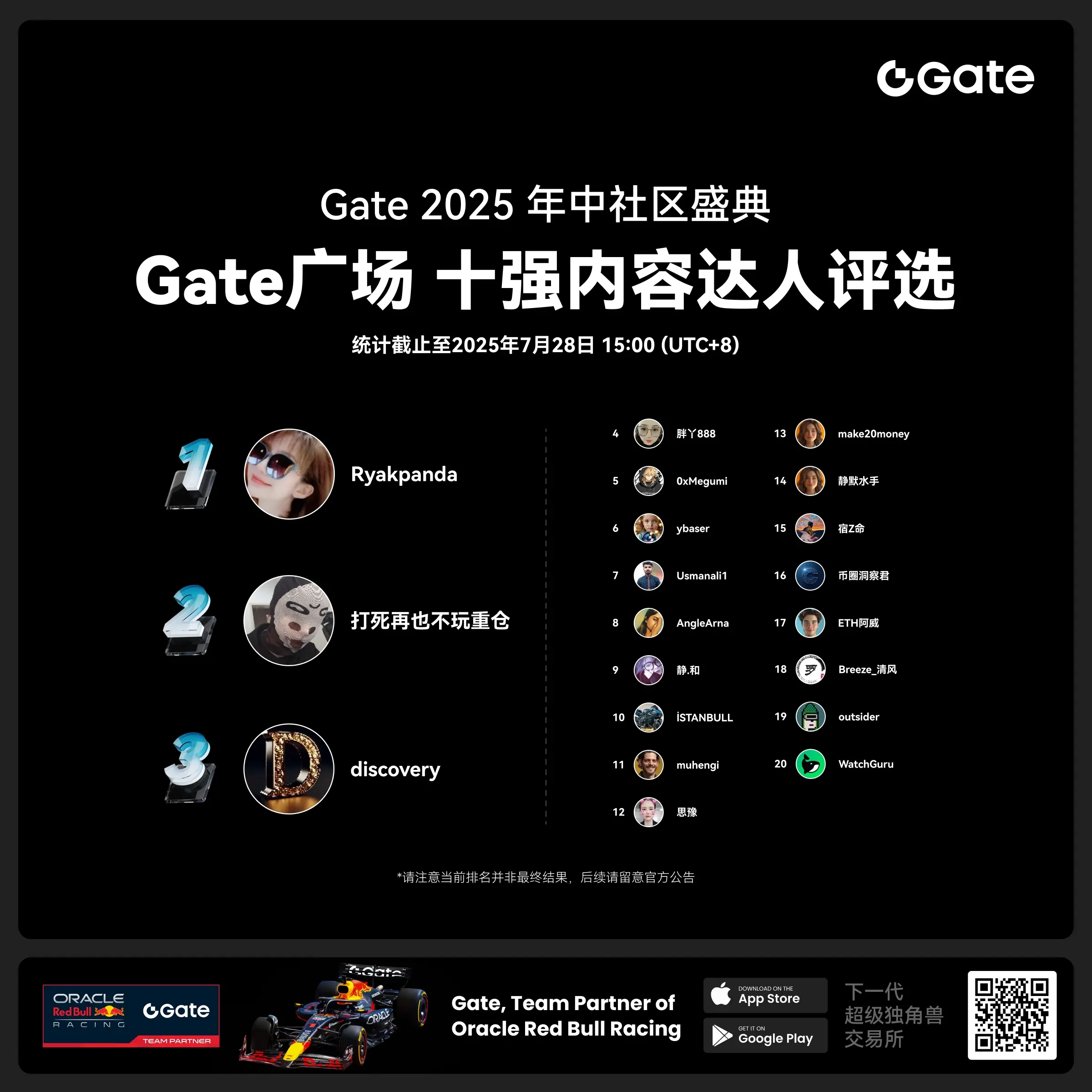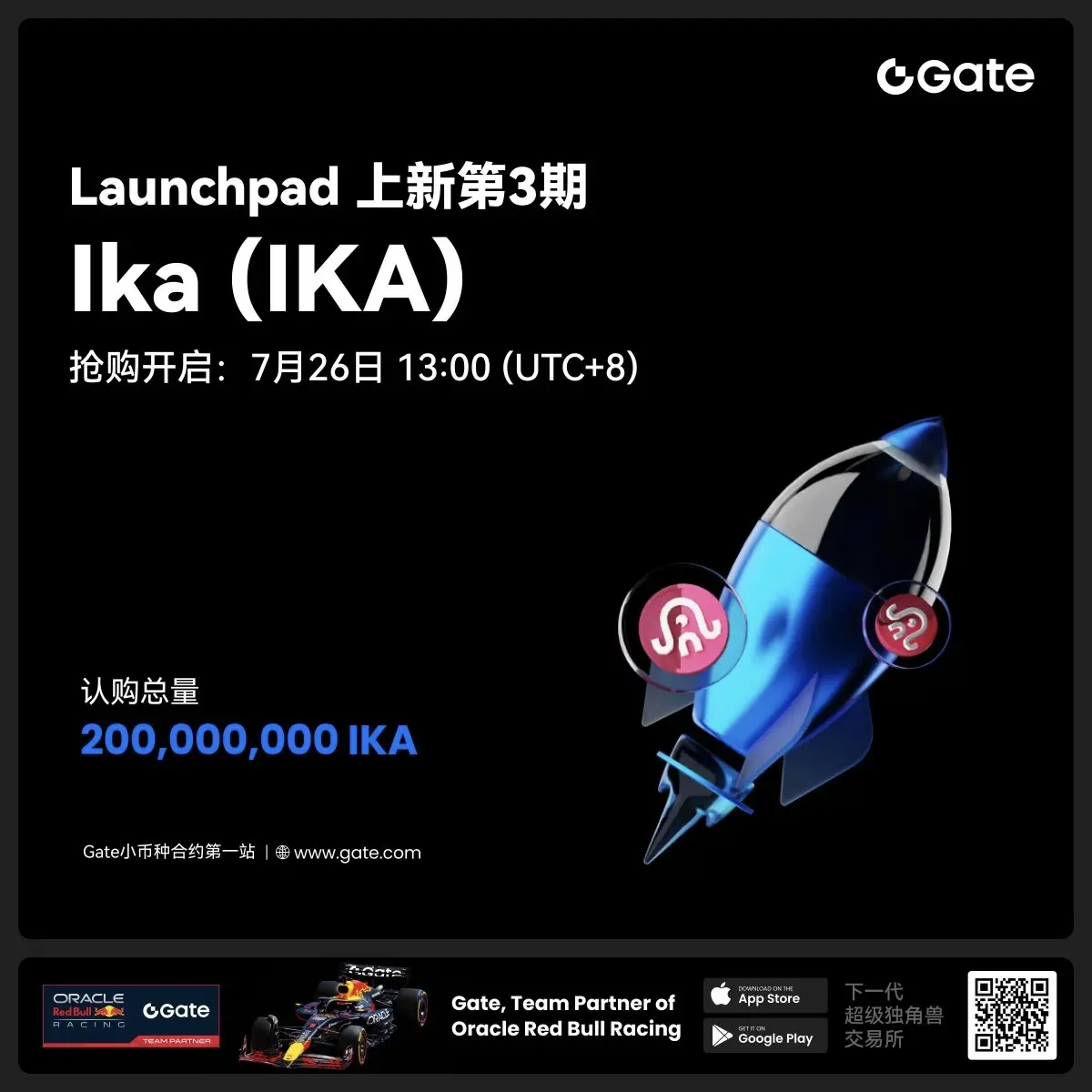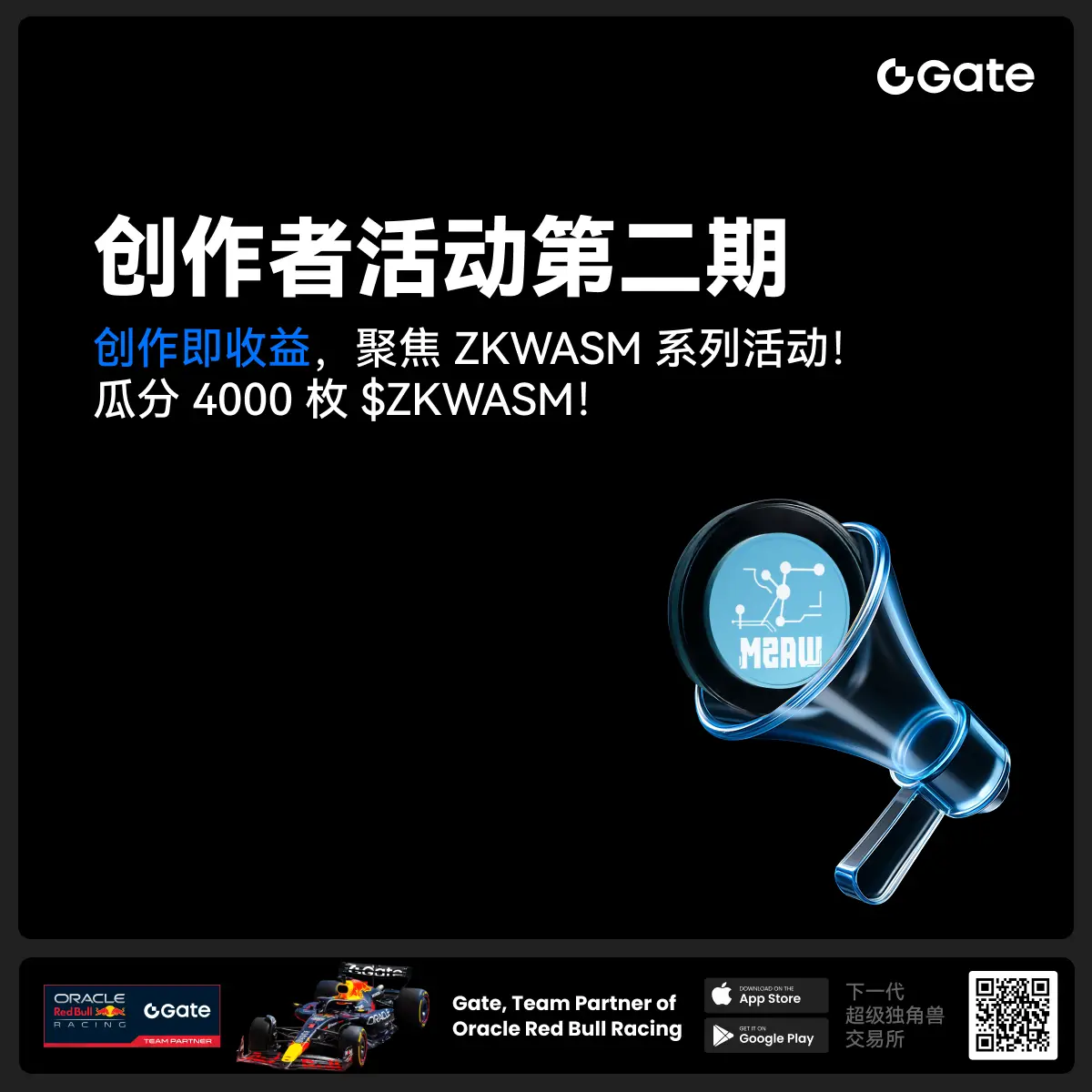- 话题1/3
55494 热度
14023 热度
45490 热度
1576 热度
1372 热度
- 置顶
- 亲爱的广场用户们, #Gate 2025年中社区盛典# 投票中!🔥
🙌 广场内容达人TOP40榜单新鲜出炉!速速围观榜单,为你喜爱的达人疯狂打call吧:
www.gate.com/activities/community-vote
每天完成【广场】互动任务可获得助力值,每投出30助力值即可参与抽奖一次!
iPhone 16 Pro Max 512G、金牛雕塑、潮流运动套装、合约体验券、热门币种等你抽!
助力越多,中奖机率越大,下一个抱走iPhone 16的锦鲤就是你!🧧
别犹豫,带上你的“欧气”,为达人冲榜赢大奖!
https://www.gate.com/announcements/article/45974
- 🎉 Gate 广场 IKA Launchpad 发帖活动来袭!🎉
Gate Launchpad 认购 IKA 最后24小时!晒出你的认购体验,和大家一起分享,每个人都有机会瓜分 $200 奖池!
🎁 4位幸运分享者*$50合约体验券每人!
🧐 如何参与:
1.在广场发帖,带上 #GateLaunchpad上线IKA# 标签
2.晒出你的认购截图 或 分享你的独特认购小窍门/心得或趣事
3.保证帖子大于50字,内容有趣有料,原创,集齐至少3个互动(点赞/评论/转发)
IKA认购链接:https://www.gate.com/launchpad/2336?downgarde=true
活动时间:7月28日 12:00 - 7月30日 24:00 (UTC+8)
赶快加入,分享你的精彩时刻,你就是下一个幸运儿!
- 📢 Gate广场 #创作者活动第二期# 正式开启!
聚焦 ZKWASM 系列活动,分享你的观点,瓜分 4,000 枚 $ZKWASM!
ZKWASM 作为 zk 公链先锋,正在 Gate 平台重磅推广!
三大活动联动上线:Launchpool 认购、CandyDrop 空投、Alpha 专属交易——不要错过!
🎨 活动一:发布广场贴文,赢内容奖励
📅 时间:7月25日 22:00 - 7月29日 22:00(UTC+8)
📌 参与方式:
- 在 Gate 广场发布与 ZKWASM 或其三大活动相关的原创内容(不少于 100 字)
- 添加标签: #创作者活动第二期# #ZKWASM#
- 附本人参与 Launchpool/CandyDrop/Alpha 的截图(如认购、空投或交易)
🏆 奖励设置:
- 一等奖(1名):1000 枚 $ZKWASM
- 二等奖(2名):500 枚 $ZKWASM
- 三等奖(10名):100 枚 $ZKWASM
📋 评选标准:内容质量、互动量、项目相关性,附活动参与截图者优先。
📢 活动二:发推赢传播力奖励
📌 参与方式:
- 在 X(推特)发布与 ZKWASM 或三大活动相关的原创内容(不少于 100 字)
- 添加标签: #ZKWASM # GateSquare
- 填写登记表 👉 https://www.gate.com/quest
- 📢 Gate广场 #MBG任务挑战# 发帖赢大奖活动火热开启!
想要瓜分1,000枚MBG?现在就来参与,展示你的洞察与实操,成为MBG推广达人!
💰️ 本期将评选出20位优质发帖用户,每人可轻松获得50枚MBG!
如何参与:
1️⃣ 调研MBG项目
对MBG的基本面、社区治理、发展目标、代币经济模型等方面进行研究,分享你对项目的深度研究。
2️⃣ 参与并分享真实体验
参与MBG相关活动(包括CandyDrop、Launchpool或现货交易),并晒出你的参与截图、收益图或实用教程。可以是收益展示、简明易懂的新手攻略、小窍门,也可以是现货行情点位分析,内容详实优先。
3️⃣ 鼓励带新互动
如果你的帖子吸引到他人参与活动,或者有好友评论“已参与/已交易”,将大幅提升你的获奖概率!
MBG热门活动(帖文需附下列活动链接):
Gate第287期Launchpool:MBG — 质押ETH、MBG即可免费瓜分112,500 MBG,每小时领取奖励!参与攻略见公告:https://www.gate.com/announcements/article/46230
Gate CandyDrop第55期:CandyDrop x MBG — 通过首次交易、交易MBG、邀请好友注册交易即可分187,500 MBG!参与攻略见公告:https://www.gate.com/announcements
- 📢 #Gate广场征文活动第三期# 正式启动!
🎮 本期聚焦:Yooldo Games (ESPORTS)
✍️ 分享独特见解 + 参与互动推广,若同步参与 Gate 第 286 期 Launchpool、CandyDrop 或 Alpha 活动,即可获得任意奖励资格!
💡 内容创作 + 空投参与 = 双重加分,大奖候选人就是你!
💰总奖池:4,464 枚 $ESPORTS
🏆 一等奖(1名):964 枚
🥈 二等奖(5名):每人 400 枚
🥉 三等奖(10名):每人 150 枚
🚀 参与方式:
在 Gate广场发布不少于 300 字的原创文章
添加标签: #Gate广场征文活动第三期#
每篇文章需 ≥3 个互动(点赞 / 评论 / 转发)
发布参与 Launchpool / CandyDrop / Alpha 任一活动的截图,作为获奖资格凭证
同步转发至 X(推特)可增加获奖概率,标签:#GateSquare 👉 https://www.gate.com/questionnaire/6907
🎯 双倍奖励机会:参与第 286 期 Launchpool!
质押 BTC 或 ESPORTS,瓜分 803,571 枚 $ESPORTS,每小时发放
时间:7 月 21 日 20:00 – 7 月 25 日 20:00(UTC+8)
🧠 写作方向建议:
Yooldo
.io域名或被剔除?16%的Web3公司将受影响
撰文:Karen,Foresight News
英国放弃英属印度洋领地查戈斯群岛的主权,并移交给毛里求斯,这一历史性的时刻标志着英国在非洲殖民主义的终结,同时,也引发了对于备受瞩目的.io 顶级域名未来的广泛讨论。
发生了什么?
地缘政治竞争日益加剧的情况下,10 月 3 日,英国和毛里求斯发布联合声明,双方已就对查戈斯群岛行使主权达成历史性的政治协议。根据该条约条款,英国将同意毛里求斯对查戈斯群岛拥有主权,包括迭戈加西亚群岛(美英的军事基地所在地)。尽管该协议尚待最终条约的敲定,但双方均承诺将尽快完成相关程序。
然而,随着英国将查戈斯群岛主权移交给毛里求斯,.io 顶级域名的未来也变得扑朔迷离。这一变更可能对众多拥有.io 域名的网站产生深远影响。因为.io ccTLD 原本被分配给英属印度洋领地(BIOT),并由一家英国私人公司 Internet Computer Bureau(ICB)负责注册,而 ICB 目前又归美国 Identity Digital 所有。
「.io」这一顶级域名源自英属印度洋领地一词的英语:British Indian Ocean Territory 中 Indian Ocean 的缩写 IO,为英国海外领土英属印度洋领地在互联网域名系统中拥有的国家及地区顶级域(ccTLD)。io 域名扩展自 1997 年以来一直存在,最早注册的.io 域名是服装公司 Levi's 于 1998 年注册的 levi.io。据英国《独立报》在 2014 年的一篇报道,「英国政府从印度洋查戈斯群岛的互联网域名的销售中获得一部分利润。根据与 ICB 公司达成的协议条款,每个 .io 域名激活时,英国政府可获得 60 英镑费用的未披露份额。ICB 创始人、互联网基础设施专家 Paul Kane 也证实,英国政府收到了使用「.io」域名所支付的部分费用。」
历史上,ccTLD 域名曾被剔除过五次
「.io」的未来很大程度上由互联网名称与数字地址分配机构 ICANN 直接决定。不过,需要知道的是,「.io」属于国家和地区顶级域名(ccTLD),政治因素考量凌驾在技术和商业因素之上。
如上所指的 ICANN 是一家位于美国加利福尼亚的非营利社团,创建于 1998 年 9 月 30 日,接管包括管理域名和 IP 地址的分配等与互联网相关的任务。据 Domain Incite 汇总,自 1998 年 ICANN 成立以来,ccTLD 仅从 DNS 根中删除过五次。除一种情况之外,所有情况下删除的触发因素都是对国际标准组织的 ISO 3166-1 alpha-2 列表的更改。
1、「.yu 」原为南斯拉夫在互联网域名系统中拥有的 ccTLD。南斯拉夫社会主义联邦共和国于 1992 年因内战而解体,但随着南斯拉夫的残余联盟国家塞尔维亚和黑山于 2006 年解体,2008 年 3 月起「.yu 」不再接受新注册申请,但直到 2010 年,ICANN 才最终将 .yu 从 DNS 根中删除。
2、「.tp」原为葡属帝汶国家及地区顶级域(ccTLD)的域名,于 1997 年官方启用,当时该国家还在印度尼西亚的占领下。2022 年该国获得独立后更名为东帝汶,ISO 为其分配了新代码 TL,并将 TP 从其列表中删除,但在 2015 年 2 月「.tp」才从 DNS 根中彻底剔除。
3、「.zr」原为扎伊尔国家搭地区顶级域(ccTLD)的域名,由于扎伊尔恢复国名为刚果民主共和国,后改用.cd。2001 年「.zr」正式停止使用。「.zr」是第一个被 IANA 剔除的 ccTLD。
4、「.an」原为分配给荷兰海外属地荷属安地列斯使用的 ccTLD 域名,2010 年荷属安地列斯解体后后,库拉索岛使用.cw 域名,圣马丁岛使用.sx 域名,博内尔岛、圣尤斯特歇斯和萨巴岛获得了 .bq 域名,ISO 也将 AN 从其列表中删除。2015 年,「.an」域名完全停止使用。
5、「.um」为美国本土外小岛屿((United States Minor Outlying Islands)的 ccTLD 域名,但没被使用。2007 年,ICAN 从域名主列表中删除了.um 域名。
然而值得注意的是,「.su」是一个特例,分配给前苏联的 ccTLD「.su」于 1990 年 9 月 19 日启用,尽管现在苏联已经解体,但是该域名目前仍然可使用。
「.io」未来何去何从?
根据 ccTLD 停用政策,ccTLD 资格由 ISO 3166-1 标准中分配的相关国家或地区决定。当国家或地区从该标准中移除时,其资格将过期,并且需要在有序过渡期后停止使用。默认情况下,ccTLD 将在五年后被删除。ccTLD 管理者可以申请延期,但需要有适当的理由。延期最多只能再延长 5 年,因此正式剔除的最长可能期限为 10 年。当然,ccTLD 管理者可自行决定提前停用域名。
如果确定 ccTLD 的资格发生变化,在互联网号码分配局(IANA)决定停用之时,会通知 ccTLD 管理者打算发布剔除通知。ccTLD 管理者将有机会指定一个替代联系人,用于处理与停用相关的通知。
正如 Domain Incite 所述,对于.io 来说,.io 域名注册者面临的核心疑虑在于:名称变更后的英属印度洋领地(BIOT)是否能继续保留 IO 分配在 ISO 列表中,以及该群岛是否依然具备获得 ccTLD 地位的独特领土资格。如果 BIOT 仅作为毛里求斯的一部分存在,不再被联合国视作独立领土,.io 域名的存续将面临严峻挑战,可能被剔除。反之,如若 BIOT 依然保持其独立领土,并保有获得 ccTLD 的资格,那么情况将会变得更为复杂。当然,也存在「.io」走上「.su」老路的可能性,但这种概率相对较小。
哪些 Crypto 公司在使用 .io?
在计算机科学领域,「IO」常被作为「I/O」(即 Input/Output)的缩写,这使得.io 域名天生适合与技术相关的服务。再加上简洁性,该顶级域十分受科技初创公司、软件公司的青睐,而且在 Crypto 领域也有很多项目使用。除此之外,.io 域名也是视频游戏项目的首选域名,因为「io」在游戏术语中代表基于浏览器的多人游戏。
据网易号「科技的世界」,「Glitch 和 GitHub Pages 都用.io 域名来用户创建的网站和应用程序,而且 Itch.io 游戏商店也使用了该域名。该域名差不多赚了 4000 万美元,这意味着可能有超过一百万个.io 域名已被注册。」值得一提的是,2021 年「Metaverse.io」域名以 114 万元成交,是当前公开成交价中最高的.io 域名。
而在 Foresight Wiki 收录的约 2 万家 Web3 公司和项目中,有近 16% 的公司使用 .io 域名,包括但不限于 Matter Labs、ZKsync、Arbitrum、Optimism、Scroll、Sei、Damus、CoinFund、Scallop、Mask Network、TrueFi、Raydium、DODO 等。值得一提的是,Gate.io 则是将带有主域名的名称当作品牌名。
至于 .io 域名何去何从,Foresight News 将持续关注。
参考: